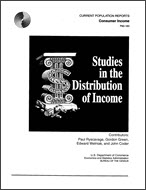
An official website of the United States government
Here’s how you know
Official websites use .gov
A .gov website belongs to an official government organization in the United States.
Secure .gov websites use HTTPS
A lock (
) or https:// means you’ve safely connected to the .gov website. Share sensitive information only on official, secure websites.
-
//
- Census.gov /
- Publications /
- Studies in the Distribution of Income
Studies in the Distribution of Income
Studies in the Distribution of Income
Introduction
The following collection of papers contains analyses relating to the distribution of income. They were motivated by two long-run economic developments: the slowdown in the growth of family and household incomes in recent years and the growing inequality in the distribution of these incomes.
From the end of World War II until the early 1970's real incomes (incomes adjusted for changes in consumer prices) of most Americans rose rapidly. Moreover, the increases were spread fairly evenly across the income distribution, and income inequality changed very little. Between the early 1970's and 1990's, however, real income growth faltered, and the income gains that did occur were among those families and households at the upper end of the income distribution.1 The result was a more dispersed and unequal distribution of income.
These developments, of course, were the cause of concern among many groups in the Nation. In the media, for example, news accounts of a declining and struggling middle class began to appear in the 1980's and they became more numerous when the economic slowdown of the early 1990's began. Politicians debated the economic problems confronting the Nation, while researchers tried to uncover the causes of slow income growth and growing income inequality.
Indeed, a significant amount of research has been conducted in this area over the years. The papers in this collection represent only a very small part of the total effort to understand the causes and implications of these economic developments.
The first study, "The Impact of Demographic, Social, and Economic Change on the Distribution of Income," by Paul Ryscavage, Gordon Green, and Edward Welniak, attempts to identify changes in the Nation's demography, society, and economy that may have been associated with income trends and rising income inequality. The second study, "Factors Affecting the Black-White Income Differential: A Decomposition," by Gordon Green, Paul Ryscavage, and Edward Welniak, examines the differential impact of the above mentioned changes on incomes and the income distribution of Black and White households. The third study, "International Comparisons of Earnings Inequality for Men in the 1980's," by Gordon Green, John Coder, and Paul Ryscavage, analyzes the rise in wage dispersion in the United States in the context of the experience of four other countries. And the fourth study, "Trends In Income and Wealth of the Elderly in the 1980's," by Paul Ryscavage focuses on the economic situation of the elderly in relation to the rest of the population during the 1980's. All authors are economists or statisticians of the Bureau of the Census.
Before turning to these studies, however, a brief overview of trends in income and income inequality during the last 20 years is presented which provides a useful framework for their reading.
__________
1 Attention to this divergence in income growth was manifested in the early to mid-1980's in the debate over the declining middle class. For example, see Bob Kuttner, "The Declining Middle," Atlantic, July 1983, pp. 60-72.
Others in Series
Publication
Publication
Publication
Share
Related Information
Some content on this site is available in several different electronic formats. Some of the files may require a plug-in or additional software to view.
 Yes
Yes
 No
NoComments or suggestions?


Top

